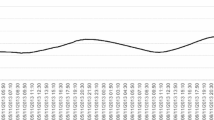Abstract
As it is known that nowadays, reduction of the heating energy loss of buildings is achieved mainly by thermal insulation. This is one of the most important objectives of buildings constructions and retrofitting of buildings. Therefore research, calculation and simulation on the energy efficiency of buildings are of great importance. In this paper we give an expansive presentation about the measurements of the thermal conductivity, heat flux and thermal resistance of individual insulation materials as well as in-built wall constructions executed in our laboratory. Thermal diffusion coefficients and wall delaying ability of the systems will be given resulting from the measurements. First of all, thermal conductivity measurement results of individual insulation materials achieved by a Holometrix type Heat flow Meter will be presented. Afterwards, two different steady-state methods for measuring thermal resistance of wall structures (Calibration hot box method and Heat Flux measurements by Hukseflux apparatus) will be introduced. These measurements were accomplished through either an inbuilt plaster/brick/plaster wall construction insulated internally at the first time and later externally with different materials. The main target of this paper is the presented theoretical procedure for the estimation of the retardation time of wall structures. Furthermore in this publication the determination of thermal performance of Expanded Polystyrene Insulation applied to walls in building constructions can also be found. Moreover numerical predictions for thermal resistance are presented. Besides, infrared thermographs were used to visualise the insulation ability of the layer structures.










Similar content being viewed by others
References
Carslaw HS, Jaeger JC (2000) Conduction of heat in solids, 2nd edn. Oxford Science Publications, New York
Changhai P, Zhishen W (2008) Thermoelectricity analogy method for computing the periodic heat transfer in external building envelopes. Appl Energy 85:735–754
Dolado P, Ana Lazaro A, Marin JM, Zalba B (2011) Characterization of melting and solidification in a real scale PCM-air heat exchanger: numerical model and experimental validation. Energy Convers Manag 52(4):1890–1907
El-Sebaii AA, Al-Ghamdi AA, Al-Hazmi FS, Adel S (2009) Thermal performance of a single basin solar still with PCM as a storage medium. Appl Energy 86(7–8):1187–1195
Farhranieh B, Sattari S (2006) Simulation of energy saving in Iranian buildings using integrative modelling for insulation. Renew Energy 31:417–425
Goia F, Perino M, Haase M (2012) A numerical model to evaluate the thermal behaviour of PCM glazing system configurations. Energy Build 54:141–153
Gustafsson SE, Karawacki E, Chohan MA (1986) Thermal transport studies of electrically conducting materials using the transient hot-strip technique. J Phys D Appl Phys 19:727–735
Hall PM, Morabito JM (1976) A formalism for determining grain boundary diffusion coefficients using surface analysis. Surf Sci 59:624
He Y (2005) Rapid thermal conductivity measurement with a hot disk sensor part 1. Theoretical considerations. Tehrmochim Acta 436:122–129
Hourston DJ, Song M, Hammiche A, Pollock HM, Reading M (1996) Modulated differential scanning calorimetry: 2. Studies of physical ageing in polystyrene. Polymer 37(2):243–247
Lakatos A, Kalmar F (2013) Analysis of water sorption and thermal conductivity of expanded polystyrene insulation materials. Build Serv Eng Res Technol 34(4):407–416. doi:10.1177/0143624412462043
Lakatos A, Kalmar F (2013) Investigation of thickness and density dependence of thermal conductivity of expanded polystyrene insulation materials. Mater Struct 46(7):1101–1105. doi:10.1617/s11527-012-9956-5
Lakatos A, Erdelyi G, Langer GA, Daroczi L, Vad K, Csik A, Beke DL (2010) Investigations of diffusion kinetics in Si/Ta/Cu/W and Si/Co/Ta systems by secondary neutral mass spectrometry. Vacuum 84(7):953–957
McCormick HW, Brower FM, Kin L (1959) The effect of molecular weight distribution on the physical properties of polystyrene. J Polym Sci 39(135):87–100
Mihlayanlar E, Dilmac S, Güner A (2008) Analysis of the effect of production process parameters and density of expanded polystyrene insulation boards on mechanical properties and thermal conductivity. Mater Des 29:344–352
Morgan AB, Harris RH, Kashiwagi T, Chyall LJ, Gilman JW (2002) Flammability of polystyrene layered silicate (clay) nanocomposites: carbonaceous char formation. Fire Mater 26(6):247–253
Niachou A, Papakonstantinou K, Santamouris M, Tsangrassoulis A, Mihalakakou G (2001) Analysis of the green roof thermal properties and investigation of its energy performance. Energy Build 33(7):719–729
Nussbaumer T, Wakili K, Tanner Ch (2006) Experimental and numerical investigation of the thermal performance of a protected vacuum-insulation system applied to a concrete wall. Appl Energy 83:841–855
Ozkahraman HT, Bolatturk A (2006) The use of tuff stone cladding in buildings for energy conservation. Constr Build Mater 20:435–444
Tay NHS, Belusko M, Bruno F (2012) Experimental investigation of tubes in a phase change thermal energy storage system. Appl Energy 90(1):288–297
Waszink JH, Hannen GEM, Hefsoni G (eds) (1990) Proceedings of the ninth international heat transfer conference, vol 3, Jerusalem, Hemisphere, New York, pp 193–198
Xiao M, Sun L, Liu J, Li Y, Gong K (2006) Synthesis and properties of polystyrene/graphite nanocomposites. Polymer 43(8):2245–2248
Xiao W, Wang X, Zhang Y (2009) Analytical optimization of interior PCM for energy storage in a lightweight passive solar room. Appl Energy 86(10):2013–2018
Yucel KT, Basyigit C, Ozel C (2009) Thermal Insulation properties of expanded polystyrene as construction and insulating materials. http://zenonpanel.com.mk/al/wp-content/uploads/2009/06/Thermal-Insulation-properties.PDF. Accessed 28 Nov 2011
Zamel N, Becker J, Wiegmann A (2012) Estimating the thermal conductivity and diffusion coefficient of the microporous layer of polymer electrolyte membrane fuel cells. J Power Sources 207:70–80
Acknowledgments
The work of the research group is supported by the TÁMOP-4.2.2.A-11/1/KONV-2012-0041 project. The project is co-financed by the European Union and the European Social Fund. “The research of Akos Lakatos was realized in the frames of TÁMOP 4.2.4. A/2-11-1-2012-0001 “National Excellence Program—Elaborating and operating an inland student and researcher personal support system convergence program”. The project was subsidized by the European Union and co-financed by the European Social Fund.”
Author information
Authors and Affiliations
Corresponding author
Rights and permissions
About this article
Cite this article
Lakatos, Á., Csáky, I. & Kalmár, F. Thermal conductivity measurements with different methods: a procedure for the estimation of the retardation time. Mater Struct 48, 1343–1353 (2015). https://doi.org/10.1617/s11527-013-0238-7
Received:
Accepted:
Published:
Issue Date:
DOI: https://doi.org/10.1617/s11527-013-0238-7




